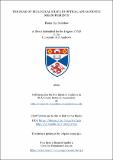Files in this item
The role of biological shape in optical and acoustic measurements
Item metadata
| dc.contributor.advisor | Brown, C. Tom A. | |
| dc.contributor.advisor | Somorjai, Ildikó Maureen Lara | |
| dc.contributor.author | Bairstow, Fiona Jay | |
| dc.coverage.spatial | 163 | en_US |
| dc.date.accessioned | 2023-03-17T11:37:13Z | |
| dc.date.available | 2023-03-17T11:37:13Z | |
| dc.date.issued | 2022-11-29 | |
| dc.identifier | The Role of Biological Shape in Optical and Acoustic Measurements (thesis data) Bairstow, F. J., University of St Andrews, 1 Sept 2022. DOI: https://doi.org/10.17630/f0f023b5-2688-4cda-bef9-bbd7460671a1 | en |
| dc.identifier.uri | https://hdl.handle.net/10023/27212 | |
| dc.description.abstract | This thesis investigates the role of biological shape in optical and acoustic measurement systems. Landmark-based geometric morphometrics (GMM) is a method of biological shape quantification based on the relationship between landmarks placed at anatomical location. GMM enables robust statistical analysis, comparisons between shapes, and visualisation of shape changes. This thesis explores the application of GMM with optical imaging for in vivo interpretation of amphioxus nerve cord shape, and acoustic measurements of Antarctic krill to improve biomass estimates. Optical imaging was performed using optical coherence tomography (OCT), an in vivo, label free imaging modality. A longitudinal study of amphioxus using OCT was conducted to capture the shape of the nerve cord during tail regeneration. Evidence for axial variation in the shape of the amphioxus nerve cord was found, however this work primarily develops a methodology and further studies are recommended to draw robust conclusions. GMM was used to construct a catalogue of realistic krill shapes for use in target strength models. Target strength is a measure of backscattering efficiency, which scales acoustic density to biomass. Typically, target strength is modelled with a generic krill shape, and distributions of length, orientation, and wetmass. This thesis demonstrates the presence of scattering mechanism influenced by shape and use of a shape catalogue to capture variability in target strength otherwise neglected. An error budget for biomass estimates of krill was developed to investigate the influence of shape and orientation. Orientation was found to have the largest contribution to the measurement error of biomass. In some cases, narrow orientation distributions resulted in biologically implausible biomass estimates due to nulls in the relationship between target strength and orientation angle. These nulls are responsive to changes in shape, suggesting the implementation of a shape catalogue could improve the accuracy of biomass estimates. | en_US |
| dc.language.iso | en | en_US |
| dc.relation | The Role of Biological Shape in Optical and Acoustic Measurements (thesis data) Bairstow, F. J., University of St Andrews, 1 Sept 2022. DOI: https://doi.org/10.17630/f0f023b5-2688-4cda-bef9-bbd7460671a1 | en |
| dc.relation.uri | https://doi.org/10.17630/f0f023b5-2688-4cda-bef9-bbd7460671a1 | |
| dc.rights | Creative Commons Attribution 4.0 International | * |
| dc.rights.uri | http://creativecommons.org/licenses/by/4.0/ | * |
| dc.subject | Antarctic krill | en_US |
| dc.subject | Euphausia superba | en_US |
| dc.subject | Geometric morphometrics | en_US |
| dc.subject | Target strength | en_US |
| dc.subject | Acoustic scattering | en_US |
| dc.subject | Biomass | en_US |
| dc.subject | Fisheries acoustics | en_US |
| dc.subject | Geostatistics | en_US |
| dc.subject | Amphioxus | en_US |
| dc.subject | Optical coherence tomography | en_US |
| dc.subject | Nerve cord | en_US |
| dc.subject | Regeneration | en_US |
| dc.subject | Shape catalogue | en_US |
| dc.title | The role of biological shape in optical and acoustic measurements | en_US |
| dc.type | Thesis | en_US |
| dc.contributor.sponsor | Engineering and Physical Sciences Research Council (EPSRC) | en_US |
| dc.type.qualificationlevel | Doctoral | en_US |
| dc.type.qualificationname | PhD Doctor of Philosophy | en_US |
| dc.publisher.institution | The University of St Andrews | en_US |
| dc.identifier.doi | https://doi.org/10.17630/sta/352 | |
| dc.identifier.grantnumber | EP/R513337/1 | en_US |
The following licence files are associated with this item:
This item appears in the following Collection(s)
Except where otherwise noted within the work, this item's licence for re-use is described as Creative Commons Attribution 4.0 International
Items in the St Andrews Research Repository are protected by copyright, with all rights reserved, unless otherwise indicated.


